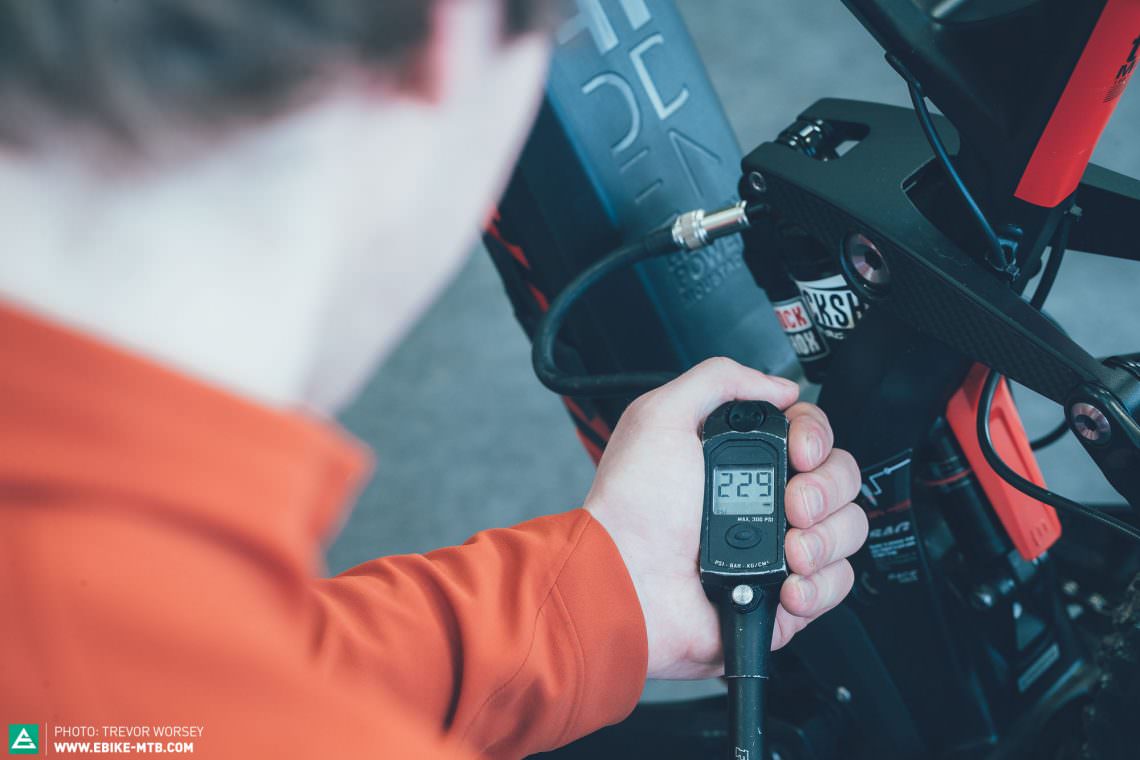Setting up your E-MTB suspension is easier than you think and can transform the feel, comfort, more range, and performance of your expensive bike. We show you how in easy steps, it only takes 10 minutes so let’s do it!
Do you know how much SAG you are running on your suspension, do you know what SAG is and do you know how to setup SAG correctly? If not, then it’s time for a quick lesson as a few simple changes could make a world of difference to your bike. The suspension units on your E-MTB are very sophisticated, but in order to function properly they needs to be set up correctly. In this quick guide we take you through a simple 10 minute guide to setting up your fork (and rear shock if you have one) to maximise your fun on the trail.
You’re not a Number
The purpose of this simple advice is to help you reach a suspension setting that is optimum for you personally. Simply following manufacturers generic pressures or copying your friends setting will result in a bike that is OK, but not perfect. Following this simple guide will allow you to obtain an optimal setting and improve your understanding of your bike.

Suspension, how Does it Work?
Before we start, let’s talk about how suspension works. Inside your suspension fork (and rear shock) there are two main components, the spring and the damper. The spring, normally filled with pressurised air, cushions you from impacts and allows the bike to respond to impacts without passing the forces through to the rider. The damper slows the fork or shock down as it responds to an impact, stopping any bouncy, pogo-stick effects and changing the kinetic energy of the impact into heat. Most dampers work by forcing oil through small holes, the bigger and faster the impact, the faster the oil needs to be forced through the ports, requiring more energy and slowing down the fork.
What is SAG?
For your suspension fork to perform correctly it must be able to respond to every contour of the trail. We all know when you hit an object your fork compresses, but to maintain traction suspension forks not only have to absorb impacts but also to extend to fill holes, keeping the tires on the ground. In order to allow the suspension to extend into holes, we have to preload the suspension with our own body weight. When we sit on the bike the percentage the suspension compresses is known as the SAG.
What do I Need to set my SAG?
To follow this guide you will need to wear your normal riding clothes, right down to your helmet and backpack – full of the same tools and water you carry on the trail. Correct setup is dependent upon weight, so there is no point tuning perfectly then strapping on a 5kg backpack. To optimize your suspension you will need a shock pump (different from a normal tyre pump), a measuring device (ruler or tape), a calculator and a willing assistant.

Setting the Fork SAG

Before you start you need to make one quick check; Many suspension forks now have a compression adjuster allowing you to change how ‘firm’ the suspension feels to help on climbs. Before you set up your SAG make sure any adjusters on your suspension are in the ‘open’ or ‘softest’ setting, you should be able to easily feel this.
Let’s begin. To set up your fork SAG find an area with plenty of room, you may find this process easier leaning against a wall or support. Unscrew the air spring valve cap on the suspension fork and place somewhere safe.

Have your assistant support the bike from the front as you climb on in full riding kit (do it next to a wall if you require more support). While holding one brake (not both or you will cause incorrect reading) bounce firmly up and down on the bike 5 – 10 times (being careful not to squash your assistant or their fingers) to prime your suspension. Assume your normal standing attack position then after allowing the bike to settle for a few seconds, have your assistant push the rubber O-ring on the fork stanchion down to the rubber wiper seal.



Carefully rock your weight back and dismount from the bike without disturbing the O-ring. Measure the distance the O-ring has been pushed up from the wiper seal in mm. Divide this number by the total travel and then multiply by 100 to get the percentage SAG (eg 32 mm / 160 mm x 100 = 20%). We recommend a fork setting of 20% for a good base setting. If the SAG is not correct you can adjust by altering the pressure in the spring with a shock pump. If you require less SAG simply add air to the fork 10 psi at a time and re-test, if you require more SAG use the pump to release air from the fork in 10 psi increments and re-test. Add or remove air in increments and repeat the O-ring process until you reach the required SAG settings.

“A balanced suspension setup is very important. Traction not only comes from the tires and terrain surface but the amount of force the rider is placing on the front and rear tire. At the very basic level, setting up sag is the first step in a balanced setup.”
– Mark Fitzsimmons, FOX Suspension Program Manager
Setting Fork SAG at a Glance:
- Dress as you would if you are going riding – including helmet and normally loaded backpack
- Put the fork in ‘descend’ mode if it has one
- Assume your normal attack position, lean against a wall or use a friend for balance
- While in position have your friend slide the O-ring down to the fork seal
- Dismount the bike and measure the % the fork was compressed under your weight (SAG)
- If the SAG is lower than 20% of travel remove air from the air spring, if it more than 20% add air to the air spring
- When you reach 20% SAG, write down the setting and go riding!
Setting Your Shock SAG
If you have a full suspension bike then you also need to optimise your rear suspension too. This is a very simple process, and is very similar to setting the fork SAG. Before you start make sure your shock is in fully open mode – if it has a compression adjuster turn it to (descend) or (soft).


Unscrew the air spring valve cap and place somewhere safe. Have your assistant support the bike from the front as you climb on (do it next to a wall if you require more support). Again, while holding one brake bounce firmly up and down on the bike 5 – 10 times to prime the suspension. Assume your normal standing attack position then after allowing the bike to settle have your assistant push the rubber O-ring on the shock stanchion down to the rubber wiper seal.

Carefully rock your weight forward and dismount from the bike without disturbing the O-ring. Measure the distance the O-ring has been pushed from the wiper seal in mm. Divide this number by the shock stroke (the length of the shock shaft) (eg 12 mm / 63 mm) and then multiply by 100 to get the percentage SAG. We recommend 30 % in the rear shock. If you require less SAG simply add air to the shock 10 psi at a time and re-test, if you require more SAG use the pump to release air from the shock in 10 psi increments and re-test.


Setting Shock SAG at a Glance
- Dress as you would if you are going riding (including helmet and normally loaded backpack)
- Put the rear shock in ‘descend’ mode if it has one
- Assume your normal attack position, lean against a wall or use a friend for balance
- While in position have your friend slide the O-ring down the shock shaft to the seal.
- Dismount the bike and measure the % the shock was compressed under your weight (SAG)
- If the SAG is lower than 30% of travel remove air from the air spring, if it more than 30% add air to the air spring.
- When you reach 30% SAG, write down the setting and go riding!
That’s it, when you have optimised your fork to 20% SAG and rear shock to 30% you are ready to ride. In our next installment we will talk about getting your rebound dialled in for maximum performance.
Did you enjoy this article? If so, we would be stoked if you decide to support us with a monthly contribution. By becoming a supporter of E-MOUNTAINBIKE, you will help secure a sustainable future for high-quality cycling journalism. Click here to learn more.
Words & Photos:









